Mali
Things to Do
Bamako
The general consensus is that Bamako was founded some time during the 16th century.
Precise details of the town's creation, however, are contested by the conflicting oral
traditions upon which the hapless historian has no choice but to rely.
The most common version of events is the Niakaté, a hunter out of the Kaarta region,
travelled down the Niger Valley to look for new hunting grounds, and met another hunter,
Samalé Bamba, who granted him a area of land upon which Niakaté founded Bamako.
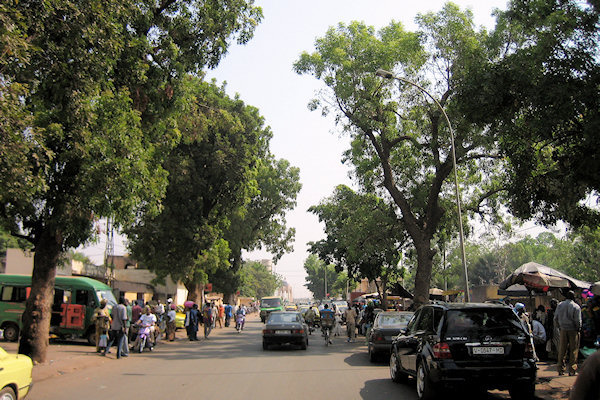 |
|||||
The main things to see are located around the Place de la République, where you can
find the Grand Mosquée, the main market and some government buildings.
The Grande Mosquée was built by the Saudis in a style more in keepingwith Mecca than
Mali. While this is not the most attractive mosque in the country, it is not as strict as
others are about letting foreigners inside.
For arts and crafts, you should go to the Artisanat next to the Grand Mosquée.
A bit of everything is sold here - woodwork, leatherwork, ironwork, jewellery, musical
instruments etc. - much of it made by craftsmen who work on the premises and might have been
taught at the Instituut National des Arts
Mali's National Museum on Route de Koulouba must be one of the most
well-presented and informative museums in West Africa. The permenent exhibits include
artefacts from almost every era of Malian history, accompanied by good written descriptions
- for now all in French, though. Another permanent exhibition is an excellent display of a
whole array of textiles, highlighting historical facts as well as details about the
different materials and techniques used to make them.
Ségou
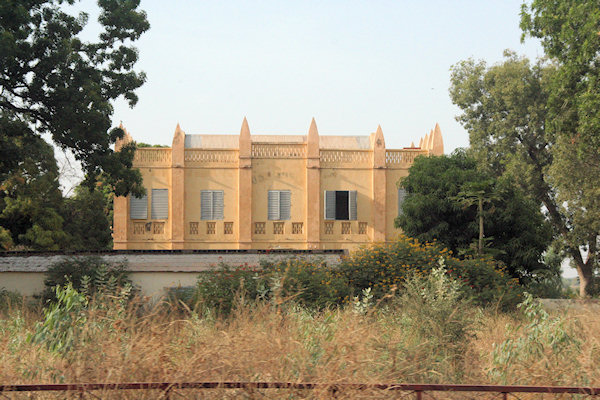 |
|||||
After independence in 1960, Ségou became the capital of the country's fourth
region and was widely recognised as Mali's second city.
It was - and still is - a town of great economic potential, being the headquuaters of
The Office du Niger and several other important national industries such as Comatex (Compagnie Malienne de Textiles) and Ségou Lait (milk).
However, this economic importance should not fool you into thinking that Ségou is an
industrial black spot full of factories, foul smells and smoke - because it is not.
Instead, spending time here can be more pleasant than some of Mali's other larger towns and,
while it does not quite deserve the label 'tranquil'; Segou is certainly
one of the least stressfull places on the tourist citcuit in the eastern part of the
country.
There is no one outstanding attraction at Ségou, but rather a little bit of everything:
the River Niger, historical villages, colonial architecture, arts and crafts, a pottery
market etc.
Ségoukoro
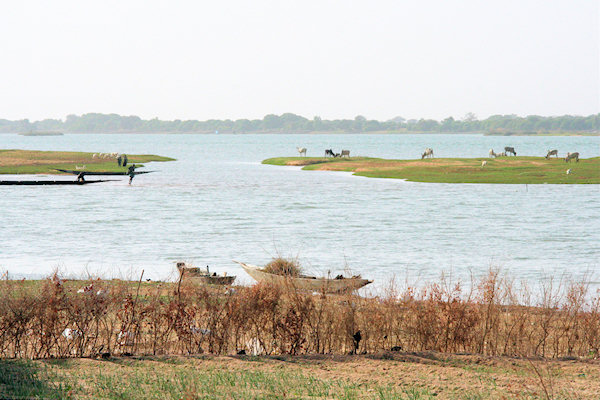 |
|||||
Today: Ségoukoro(old Ségou) is a small village 10 km from Ségou
along the road to Bamako.
In the 18th century it was from here that the Bambara kings ruled a kingdom
which stretched for thousands of kilometres across West Africa
- from the dessert in the north to Tengréla (Côte d'Ivoire) in the south
and from Kouroussa (Guinea) in the west to Lake Débo in the east.
The tomb of the founder of this kingdom, Biton Coulibaly (1712-1755),
is still in the village, along with three mosques, one built by Coulibaly
for his Islamic mother, Ba Sounnou Sacko - the king himself was animist.
Guides will routinely show you the tomb and mosques, but also take time
to explore the village itself - the Sudanese architecture, granaries and
activity down by the river
Djenne
Town
Djenné was founded in the 13th century and became an important commercial centre, frequented by traders of the central en western Sudan and those of the Guinea's tropical forest. Gold, slaves and kola nuts coming from the south were exhanged for Saharan salt, making the town one of the richest and most cosmopolitan in Africa. Indeed, the influence of Muslim traders from North Africa contributed to Djenné's conversion to Islam.
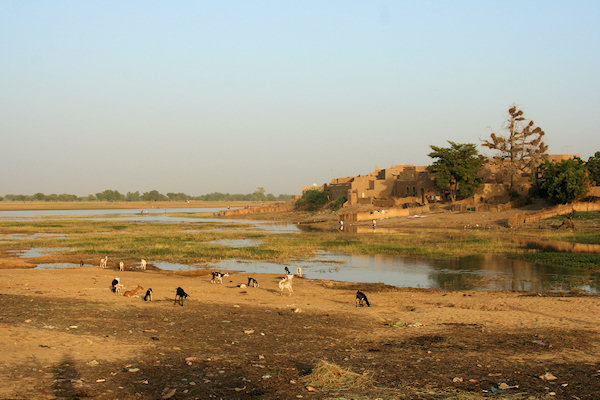 |
|||||
Djenné was named a World Heritage Site in 1988 to preserve its unique architectural
integrity.The traditional Djenne's houses have stood the test of time thanks to the continued
presence of the town's expert masons (Mud-builders) and a seven-year project - financed by the
Dutch governement - to restore and rehabilitate traditional houses to their former glory.
According to oral tradition, Djenné owes its existence to a young Bozo girl called Pama
Kayamtao. As the town was being constructed, the presence of bad, malevolent spirits caused
buildings to collapse as soon as they had been built.
Marabouts turned to the good spirits
for help and were told that the problem could only be solved if a young Bozo virgin was buried
in the city wall. Pama Kayamtao was sacrificed so that Djenné could be built. The tomb of
Tapama (meaning 'our mother Pama') Djenepo (meaning 'corpse of Djenné') is behind the
mosque near the banks of the river.
Mosque
The mosque at Djenné is the largest mud structure in the world: it must also have a claim to be
the most beautiful. It dominates Djenne's central square and is the town's pièce de
résistance.
The Djenné Mosque is sometimes called the Konboro Mosque in deference to King Koy
Konboro, the 26th ruler of Djenné, who converted to Islam in the 13th century and, intoxicated
with new-found devotion, knocked down his royal palace and built a huge mosque in its place.
The structure survived until the arrival of the Peul fundamentalist, Sékou Amadou, in the
19th century.
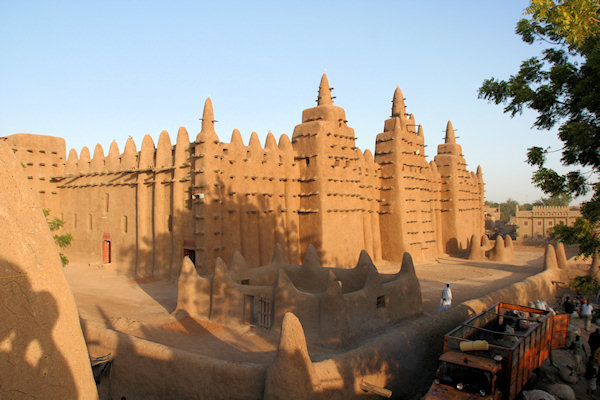 |
|||||
As a student in Djenné, Amadou had been shocked by the liberality of the townsfolk
and the practice of singing, dancing and drinking millet beer in front of the mosque.
Therefore, when he captured the town in 1819, he abandoned the Konboro Mosque - which he considered
to be 'contaminated' by evil practices - and let it go to ruin because the Koran forbids the
actual destruction of a mosque by a fidèle (Faithful Muslim). Meanwhile, a new, more sombre
mosque was built on a site east of the old one and was inaugurated in 1834.
The present-day mosque dates from 1907 and is constructed on the foundations of Konboro's original
structure - Amadou's effort was pulled down and a medersa (Muslim college) built in its
place.
Vieuwed from the outside, the mosque's architecture is classically Sudanese. The Three minarets are
each more than 10m high and, along with the rest of the structure, are riddled with bunches of
wooden sticks or toron, which are used for decoration and as scaffolding when repairs become
necessary - after the rains, for example. There are two entrances: the one on the southern side
(ie: facing away from the market place) is the more ornate, while the northern entrance is
characterised by six steps leading up to it. The whole mosque is raised 3m above the level of
the market place, and these six steps symbolise the transition from the profane to the sacred.
Inside, the mosque is equally impressive. the prayer area is some 50m by 26m, and 90 pillars hold
up the wooden roof.
Unfortunately, infidels are not allowed inside the mosque.
Monday Market
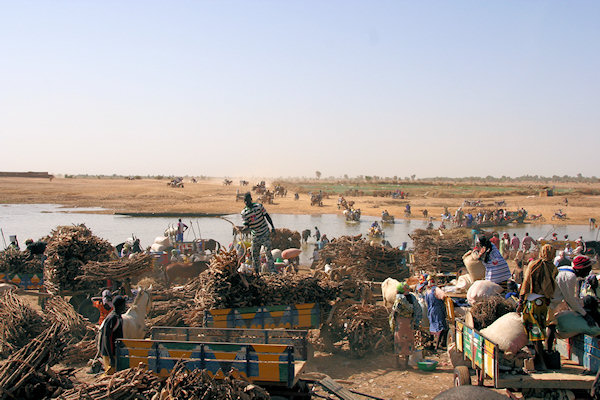 |
|||||
Djenné may no longer be the commercial powerhouse it once was, but it can still boast one of the
most colourful markets in West Africa.
Every Monday, the town's population roughly triples as people from surrounding villages and as
far afield as Bamako and Sikasso come to sell their wares.
Although the range of items for sale is bewildering, the real attraction of the Monday market
for the visitor is its colour, animation and imposing location in front of the famous mosque.
Try to be there in the early hour's and watch things getting started.
Bandiagara
Town
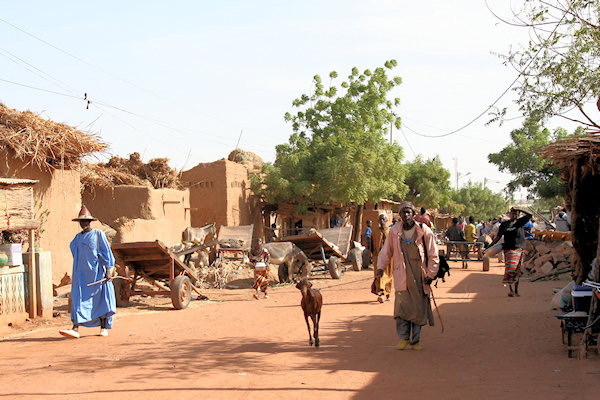 |
|||||
Bandiagara is base camp for any visit to Dogon country.
Whether you intend to access the cliffs via Sanga or Djiguibombo, or want to see some of the villages
on the plateau, Bandiagara is hard to avoid.
For this reason, there are several hotels and restaurants, and plenty of guides - but no bank.
Bandiagara is a reasonably-sized town which, by Dogon standards at least, is cosmopolitan and
busy.
The largest market on the plateau takes place here on Mondays.
Festival Culturel et Artistique de Bandiagara
Throughout Mali and throughout the year there are numerous festivals and traditional festivities.
Many of these events are open to the public and some events have in fact been designed or
reshaped for the benifit of tourists. In other cases, festivities are first of all local
celebrations or rituals, but visitors are welcome.
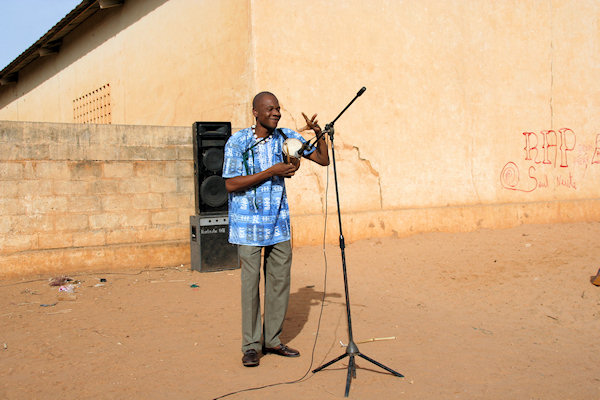 |
|||||
Festival Culturel et Artistique de Bandiagara is held at the end of december. This was
the 3rd edition. There was a published schedule for the five-day affair. The same each day with
different sponsors–mostly themed for the community–AIDS, women’s groups etc.
First there was a local player/singer "Sida Omatho" ; then a traditional dance of
mostly women.
The third act Les Chasseurs was a dance of warriors. About 20 guys with
muzzle loading rifles which they shot off occasionally. They acted out hunt and fighting
scenes.
Then the tour de force. The Dogon Masked Dancers. An old apparently dying tradition,
particulary in a large more commercial town like Bandiagara. About 15 men in costume and large
masques.
The festival was good on many levels. Great entertainment and insight into some of the culture;
and apparently helping keep allive the traditions for the locals. The kids in particular loved
it–hundreds were crowded around.